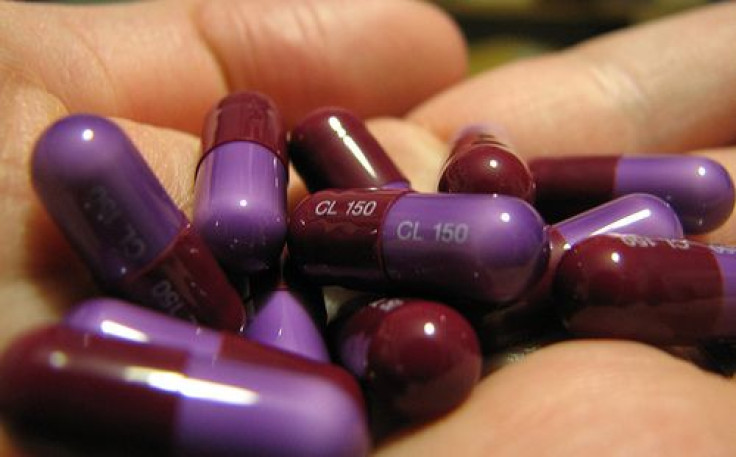3 Germs Pose Urgent Threat To US Health Because Of Antibiotic Overuse: CDC Threat Report 2013

The Centers for Disease Control and Prevention (CDC) has released the first-ever snapshot of how antibiotic-resistance bacteria endangers the United State population, breaking down the list into three grades of threat: urgent, serious, and concerning.
Antibiotic overuse has led to the growth of drug-resistant bacteria that are insusceptible to future medications. As a result, over a dozen germs have landed on the CDC’s list, three of which — one that causes life-threatening diarrhea, one that causes bloodstream infections, and one that is passed sexually — call for “urgent public action,” as the CDC classifies them as “immediate public health threats.”
The Top Three
The three bacteria are Clostridium difficile, Carbapenem-resistant Enterobacteriaceae, and drug-resistant Neisseria gonorrhoeae. Each bears uniquely threatening properties that have become immune to antibiotic defenses.
Clostridium difficile: These bacteria cause life-threatening diarrhea and manage to rack up $1 billion in excess medical costs each year. People who most often get C. difficile have recently received antibiotics or were recently hospitalized. Roughly 14,000 people die each year from the bacteria, and rates have gone up 400 percent between 2000 and 2007, primarily because a stronger, more resistant strain emerged in 2000.
Carbapenem-resistant Enterobacteriaceae (CRE): CRE have become resistant to all or nearly all available antibiotics, the CDC report states. Half of all those with bloodstream infections from CRE will die from the infection. With 600 annual deaths, the bug mainly infects hospital patients.
Drug-resistant Neisseria gonorrhoeae: The bacteria that cause gonorrhea, a sexually transmitted disease that “can result in discharge and inflammation at the urethra, cervix, pharynx, or rectum,” have seen greater resistance patterns over time. Where penicillin once treated the disease, stronger strains have flourished unabated. If it becomes widespread, “the public health impact during a 10-year period is estimated to be 75,000 additional cases of pelvic inflammatory disease (a major cause of infertility).”
Along with these three, 11 bacteria and one fungus populate the Serious Threat column and three more bacteria — two Streptococcus bacteria and one Staphylococcus bacteria — round out the Concerning Threat group.
"It's not too late" for the U.S. to take productive, proactive measures by limiting antibiotic use for critical situations, but several steps are needed right away, CDC director Tom Frieden said in a telephone news conference. "If we are not careful and we don't take urgent action, the medicine cabinet may be empty for patients with life-threatening infections in the coming months and years."
What The Public Needs To Know
As antibiotics become the de facto means of treatment for bacterial diseases, the once vulnerable strains become increasingly more resistant. This happens two ways, each working in tandem. On the one hand, humans receive antibiotics and develop resistant bacteria in their gut; this happens naturally as more good bacteria get killed and the already resistant bacteria survive. When people receiving the meds get admitted to the hospital, infectious diseases can spread far more easily, as patients have weakened immune systems. In the general community, bacteria are traded normally through daily interactions.
On the other hand, animals receive antibiotics that undergo the same processes in their gut. When these animals reach the slaughter, the bacteria that were in their body stay on their meat. If not handled properly, the bacteria on these meats can transfer to humans during consumption. In fertilizer containing animal feces, the bacteria can spread through contact with the humans who use the fertilizer. In both cases, the animal’s drug-resistant bacteria persist in some capacity and, through misuse, contact with humans.
The CDC took several factors into account when compiling their Threat Report, which also serves to educate the general populace on how to avoid the resistant bacteria. It looked at the bugs’ health impact, economic impact, how common they are, how common they could become, how easily they spread, how well they still respond to medication, and how difficult they are to prevent.
Prevention-wise, the easiest way to avoid developing such strong bacteria is to avoid antibiotic use when unnecessary, in both humans and animals.
“The more that antibiotics are used today, the less likely they will still be effective in the future,” the report states. “Therefore, doctors and other health professionals around the world are increasingly adopting the principles of responsible antibiotic use, often called antibiotic stewardship.”
Stewardship includes making sure accurate assessments are being made as to the best practice for treating each patient. Correct dosages, timing, and responses to allergies all need to be taken into account to maintain good antibiotic stewardship, the CDC says. More efficacious stewardship programs shorten patient stay and improve their overall care, making hospitals generally safer and less susceptible to infection.
Personal Responsibility
Other steps include regular hand washing, safe food handling, keeping up with vaccinations, infection-control plans in hospitals, and facilitating the advancement of antibiotic drugs and tests for drug resistance. The process should also include giving more financial backing to companies wishing to develop antibiotics, giving the Food and Drug Administration more power to quickly approve and regulate new antibiotics, and making sure all hospitals, nursing homes, and rehabilitation facilities follow best practices for using antibiotics, according to board member of the Infectious Diseases Society of America, Helen Boucher.
"We want to make sure we use the right antibiotic in the right patient in the right dose at the right time," she said.
Patient responsibility also plays into the safety measures outlined by the CDC. Understanding a doctor’s prescription, and questioning its purpose and risks, can help arm patients with appropriate information so that antibiotic-resistant bacteria pose as minimal a threat as possible.
"If you are not comfortable asking questions, force yourself anyway,” Michael Bell, deputy director of CDC's division of health care quality promotion, told USA Today, “Ask, 'What are you doing to make sure my mom doesn't get an antibiotic-resistant infection?'"



























